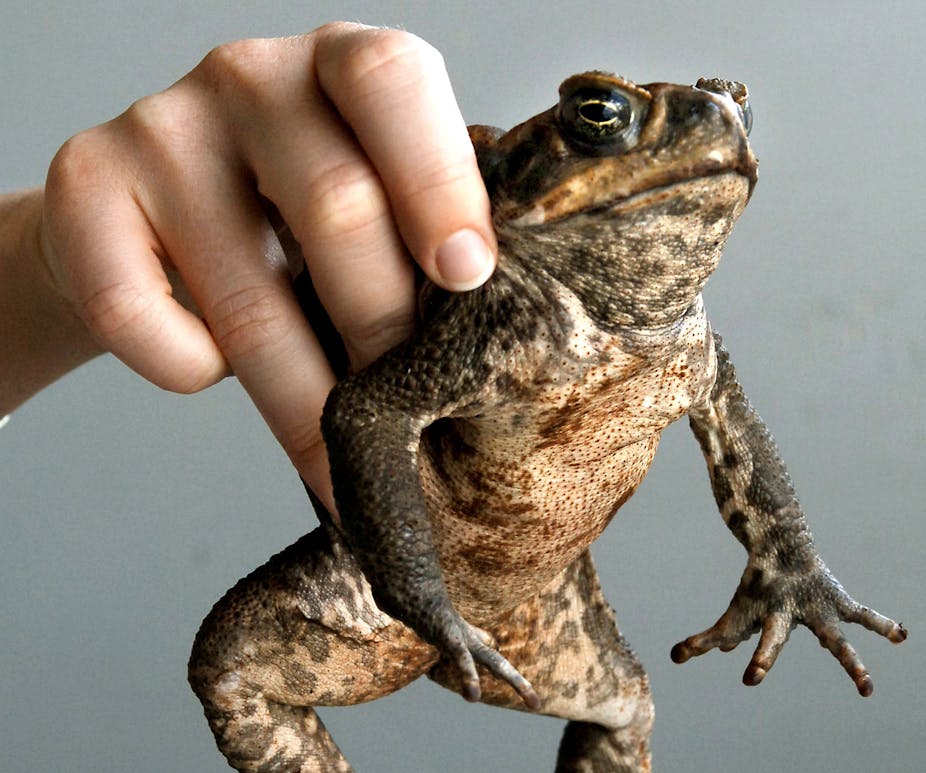For some unfathomable reason, cane toads stir the popular imagination. Most invasive species are simply not noticed by most of us, or, if they are, they are quickly assimilated into our mental landscape and forgotten. Who watches a honey bee flitting between dandelions and thinks “invasive species, both of them”?
Very few invasive species generate even a flicker of concern, and of those that do the cane toad is surely the one that attracts the most visceral of reactions: people either love them or hate them.
Why are toads here? What is their real impact on Australia’s native species? And what, if anything, can be done to stop them? Research over the last decade has revealed substantial new insights into these questions.
Toads were brought to Australia in 1935 by scientists working for the sugarcane industry. Australian toads had a long journey. They were originally native to South America, and came to Australia on a tide of enthusiasm for their ability to control beetle pests of sugarcane. This enthusiasm was ill-founded and naturally receded, but by then toads were already ashore in Australia as well as 22 other countries throughout the Caribbean and Pacific.
The introduction of toads in Australia occasioned little fanfare and generated little concern. Following the toads’ initial introduction in north Queensland, however, a lone but powerful voice (belonging to one Walter Froggat) raised fears that toads “may become as great a pest as the rabbit or the cactus” and that “there is no limit to their westward spread”. Froggat’s agitation caused an immediate ban to be placed on the further release of toads. This ban, in turn, caused the sugarcane lobby to exert political pressure. Within months word came from the Prime Minister’s Office that the ban was to be lifted, and toads were immediately liberated as far afield as Mackay and Bundaberg. There was no stopping the sugar industry’s saviour now.
Since then, of course, Froggat’s predictions have proved prophetic. Toads now occupy more than 1.4 million square kilometres of the continent. Their range is continuous from northern NSW to the eastern Kimberley, and they continue to invade new areas. Sugarcane beetles are now controlled with insecticides.
Cane toads grow to be larger than any native Australian frog, but they also carry with them powerful cardio-active toxins that no native frog species produces; it is this toxin that inflicts the most environmental damage. There is little doubt that as toads spread they caused the death of countless thousands of native predators - quolls, goannas, crocodiles, snakes, and frogs - which, naive to the toads’ toxic nature mistook them for something edible.
Despite this carnage, however, toads have never, to the best of our knowledge, sent a native Australian species to extinction. There have certainly been local extinctions, particularly of quolls, goannas and some snake species, but in at least some places populations of native predators persist. How they do so is a fascinating story of its own, involving a diverse range of responses including rapid evolution and learning. Additionally, when toads remove goanna predators from a system, many other species (whose eggs and adults are preyed upon by goannas) may end up benefiting.
Nonetheless, for some native predators - goannas, snakes, and quolls in particular - the arrival of toads is dire news indeed. We shouldn’t have introduced toads and we should do what we can to limit their impact. Unfortunately, the toads’ staggering reproductive potential (5,000 - 30,000 eggs at a sitting) makes them a daunting adversary.
To make matters worse, toads have evolved to become highly dispersive during their invasion of northern Australia, where adult toads will regularly move 50km in a wet season. This combination of high reproductive rate and impressive dispersal ability makes controlling toads a formidable (some might say impossible) challenge. Compared to toads, rabbits, foxes and cats look easy.
Nonetheless, research on the basic ecology of toads has unearthed many surprising facts, some of which can be bent towards toad control. Perhaps the most grisly of these is that toads are cannibalistic, and toad tadpoles (toadpoles) like nothing more than a snack of fresh toad egg. To find fresh toad eggs, toadpoles home in on the very same toxin that makes toads so dangerous to our native predators. Thus, a simple yabby trap, baited with soluble toad toxin, will rapidly catch thousands of toadpoles but won’t attract anything else.
Local control strategies such as this, when executed at the right place, can have profound benefits. By denying toads access to 100 artificial waterbodies in the right place, for example, we can totally prevent the natural spread of toads into Western Australia’s Pilbara region. Doing so would prevent the natural spread of toads into 268,000 square kilometres of suitable habitat (an area the size of Great Britain) and help secure some of the last healthy mainland populations of quolls and goannas that are currently unaffected by toads.
Love them or hate them, toads are here to stay. Their biodiversity impact is probably less than the public imagination would have it, but also substantially more than we would like.
New strategies, built off basic research into the ecology of toads, provide new means of reducing their local abundance, and even of halting their spread across northern Australia. Executing these strategies will require substantial participation and interest from the public. Not the kind of interest one might get for proposals to control dandelions, but interest of the more intense and visceral kind; the kind of interest aroused by toads.

